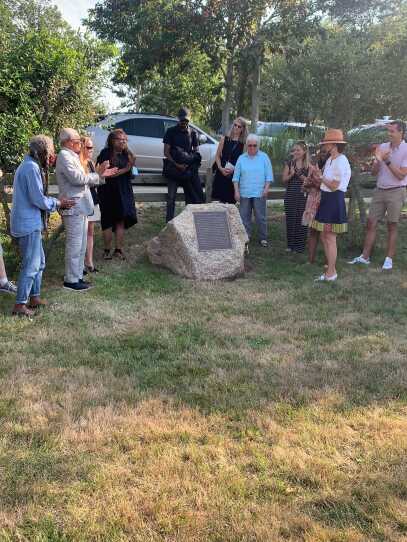When you first step off of the ferry and onto Nantucket, you’re greeted with the hectic scene of fellow passengers disembarking and swarming the wharves, searching for friends, families, lovers and respite from the demands of life on the U.S. mainland.
But push against the current of bodies that crowd Broad and Main Streets; make your way southwest among the smaller houses that populate the similarly smaller streets — all the way to the corner of Angola and North Mill Street, to a field cordoned off by a split rail fence. Enter that field and look south, and regard the boulder that rests in the grass. It’s a monument to Arthur Cooper whose story — of self-emancipation from slavery, an escape to Nantucket and rise to community leader — is a fascinating saga by any known metric.
But remembering Cooper also keeps alive a history of the old Island that some residents and academics are fighting for. So, it was only natural for The Museum of African American History, the Nantucket Land Bank and the Nantucket Historical Commission to memorialize his life, in a park off the street on which he lived.
About 100 people gathered in the park for the dedication of the monument to Cooper on Thursday, August 12, and to hear a number of speakers reflect on the importance of this kind of historical preservation.
“This monument tells the story of a community that's recognizing their historical impact,” said Museum President & CEO Leon Wilson. “And they're announcing that again today, the importance of that support.”
Arthur Cooper was born into slavery in Virginia, in 1789. But he escaped his enslaver, David Ricketts, and stole himself away across the Mason-Dixon line and into the city of New Bedford. He got a job, married (some records show his wife’s name as Mary; others as Lucy), and he and his wife had several children. In 1820 they came to Nantucket, but two years later, danger arose: an uptick in the search for self-liberated freedmen, to traffic them back into bondage. By October 1822, slave catcher Camillus Griffith was on a mission to recapture the family, but the Island’s Quaker and Black communities whisked the Coopers into hiding, while Alfred Folger, the Nantucket magistrate, delivered a ruling that the Coopers could not be forcibly removed. Arthur Cooper went on to become a leader on Nantucket, eventually a founder of the Zion Methodist Episcopal church. He died in 1853.
In the academic world, even in the realm of African American history, Museum of African American History Director of Learning L’Merchie Frazier estimates that “very few scholars were aware of Arthur Cooper’s story.” These stories have remained hyperlocal, and knowledge of the tale drops the further you get from the community. She chalks this up to the relative isolation of Nantucket. “There are few volumes that you can find that give you the details of what happened here,” Frazier observed. “So this marker is very important and significant to uncover that voice of Black community and its reach into a story that is extremely complex.”
This monument to Cooper does more than preserve his life story. It can also serve as a tangible symbol for the importance of historical preservation writ large, and remembrance of erased Black communities — as well as an ongoing battle between the community of Nantucket and incoming developers with luxe blueprints.
Angola Street today is relatively empty. The streets are narrower here; foot traffic slows, and parks and open fields abound. But in Cooper’s day, the street — incidentally the only street named after an African state — was part of the thriving Black community of New Guinea. This monument serves as a reminder of that history, and that of the community as a hotbed of anti-slavery and abolitionist activity.

But as time marched forward, the Island became much whiter: at one point, Black Americans made up nearly half of the Island’s population; today, that number is closer to 11%. By the 1970s, Nantucket became a prime location as a summer retreat. If you knew nothing about its past and wandered Angola Street and its adjoining lanes today, and that Cooper monument wasn’t there, there’s a good chance you wouldn’t pick up on this tranche of the Black American story.
But that monument is there, and now you can. And that’s vital to the preservation of the Island’s historical identity. “That kind of visceral feeling of historic agency is something that, I think, you receive when you’re in an intact, historic community that’s a living community,” said Hilary Hedges Rayport, Chair of the Nantucket Historical Commision. That feeling is hard to come by when you’re surrounded by new developments out of step with what she describes as the “historical integrity” of the Island.
But the grand irony of this situation, as well as the best case for why this Cooper memorial is so important, was perhaps described by Brian Corr, of the Religious Society of Friends — also known as the Quakers: “We have to understand that this empty Angola Street that is just starting to have houses, is empty because of who used to live here, and who does not live here now.” The physical remains of that Black community are scant; the presence of new developments on top of old New Guinea is something some residents are fighting against. A monument like Cooper’s tells a story, but it also is a reminder that nothing is an isolated incident.
Update: An earlier version of this story included a photo that was incorrectly identified as being an image of Arthur Cooper.







